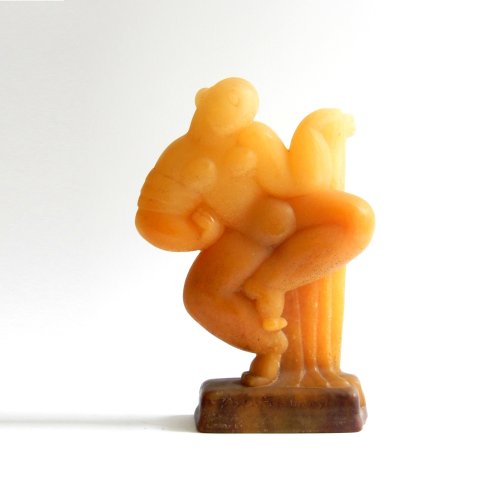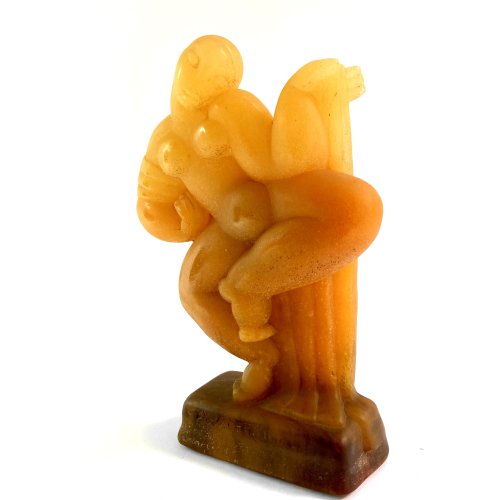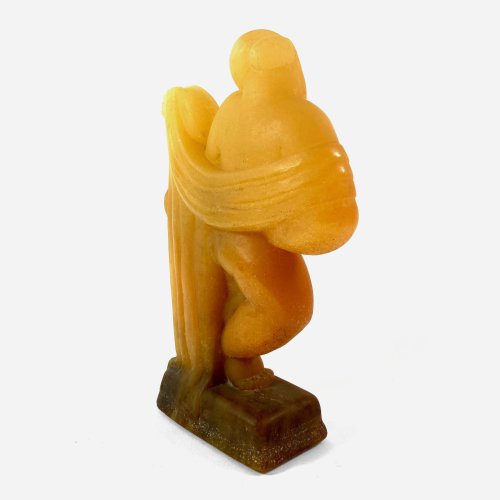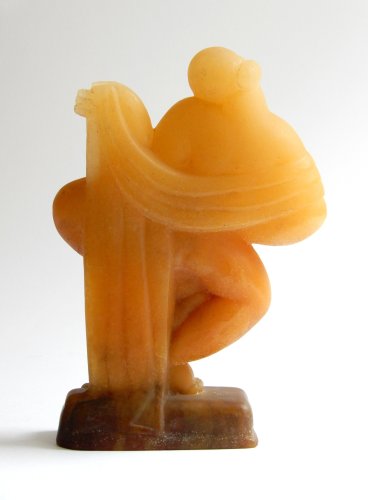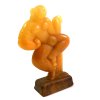Amalric Walter (1869-1959) Dancer
About this piece
Beautiful sculpture of a dancer made by the glass artist Amalric Walter in the 1920s. This sculpture of a dancer is a very rare work by Walter.
The dancer stands in a characteristic dance pose, the work is stylized and made in the style of modernism.
The dancer is so expressive, she is full of joy, all 'Joie de vivre'.
This sculpture with its deep ochre yellow colour is made of pâte de verre, a glass paste that Amalric Walter was specialized in. The size is very nice, 23 cm H. and it weights almost 3 kilo's .
Amalric Walter belonged, together with François Décorchemont, Argy-Rousseau, Henri Cros, Albert Dammouse and Georges Despret, to the great glass artists who at the time mastered the technique of working with pâte de verre.
The sculpture is signed with 'A. Walter Nancy'.
Biography:
Amalric Walter (France, 1870-1959) was a
very good glassmaker who was originally trained as a ceramist in Sèvres.
He was already experimenting with pâte de verre when Antonin Daum
persuaded him to join Daum to further develop the making of vases and
figures in the difficult, newly rediscovered pâte de verre. Which he
did, with great success. The beginning however was difficult, he got his
own room and oven at Daum for his experiments. His first success were
the Tanagra dancers, very popular at the time. They were still
monotonous in colour, often light browns.
Later he worked closely
with Daum's chief designer Henri Bergé (1868-1936). He also taught
applied arts at the École professionnelle de l'Est.
Bergé designed
all kinds of small utensils for Walter, often in a colourful palette. They became good friends.
From
1919 to 1935 Walter worked as a self-employed person and started his
own studio. He then continued to collaborate with Henri Bergé, he also
collaborated with various other artists.
Bergé died in 1936, which had a
major influence on Amalric Walter, he himself was already visually
impaired, in 1953 he was even completely blind.
Walter is best
known for his animal figures made of glass paste, but also for his vide poches, inkwells, boxes and paperweights, often decorated with all kinds of animals such as butterflies, insects, lizards and flowers. Also very known are his various pendants, these were often worn with a silk cord by the most
modern ladies from the better circles in the 1920's.
Besides Henry Bergé Walter also worked with other artists, a nice example of this collaboration is this beautiful sculpture of a dancer.
Amalric
Walter did not have a high production, each design was made in small
editions, partly because of this his work is sought after and can be
found in various private and museum collections.
Literature:
- François le Tacon & Jean Hurstel; 'Amalric Walter, Maître de la pâte de verre', Edition Serpenoise, Metz Cedex.
-
Philippe Olland; 'Dictionnaire des Maîtres Verriers de l'Art Nouveau á
l'Art Déco Marques & signatures, Éditions Faton 2016. P.326-331.
- Victor Arwas, 'Glass, Art Nouveau to Art Deco', Academy Editions London 1987. P. 353-359.
-
'What is art nouveau & art deco waard', part I&II, editors Rob
Zeegers Janny Stuurman-Aalbers and Reinold Stuurman, Publisher Scriptum
Art , Schiedam, NL and Snoeck-Ducaju & Zoon, Ghent, Belgium, 2001.
Part II, p . 110, 229, 322.
Condition
Excellent
Material:
Pâte de verre
Measurements:
Width: 16 cm
(6,3")
Height: 23 cm
(9,06")
Depth: 5 cm
(1,97")
Weight:
2.804 grams
(98,91oz)
Year:
approximately 1930
Origin:
France
Artist / atelier:
Amalric Walter,
